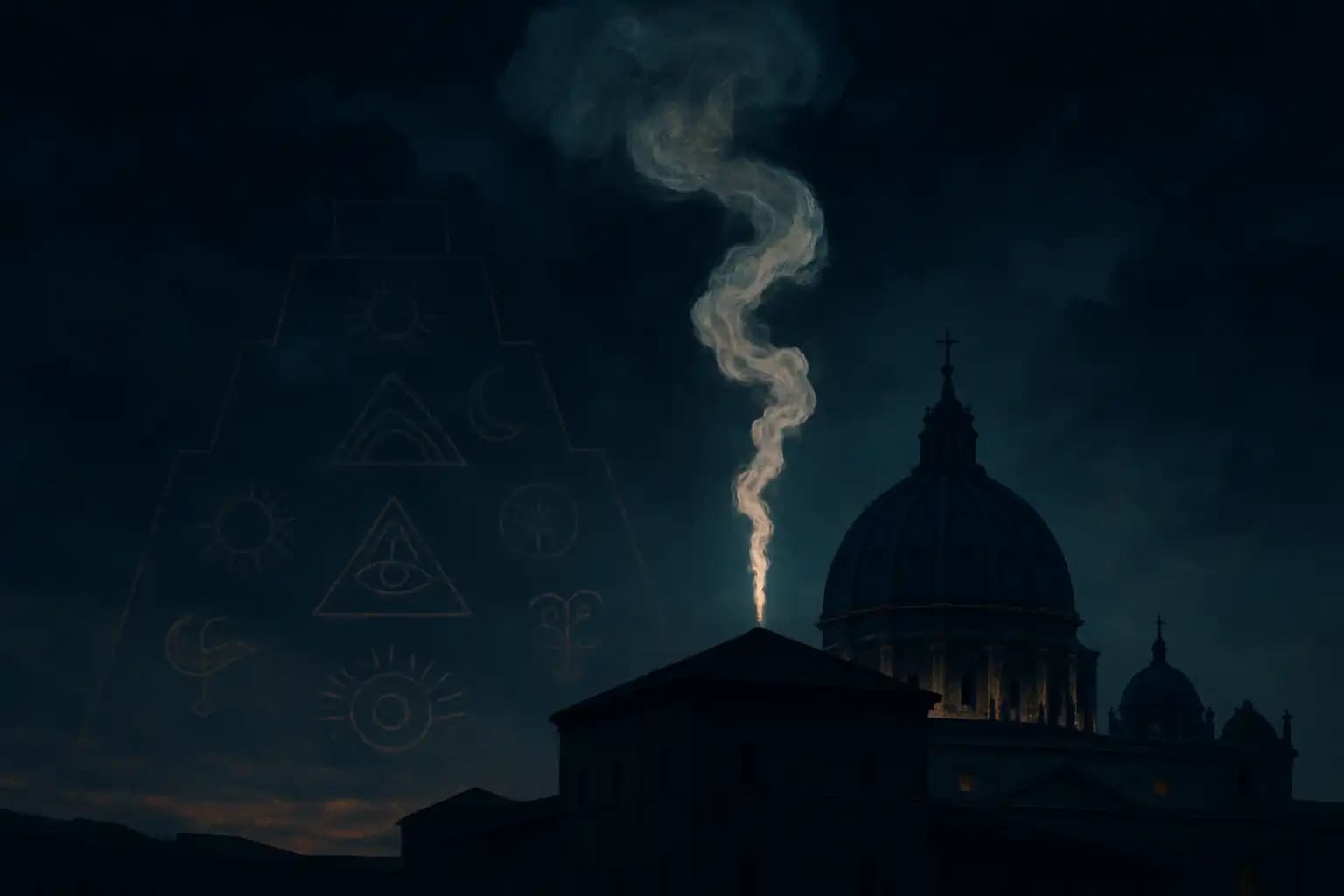I’m Art, broadcasting from my bunker with one eye on the Geiger counter and the other on Vatican live streams. On May 8, 2025, the Sistine Chapel chimney released its trademark white plume—“Habemus Papam!”—and polite society exhaled. Down here, I inhaled instead; that smoke smelled like dusty ziggurats along the Euphrates, not cherry incense. If you’ve read Alexander Hislop’s The Two Babylons, you know the scent: centuries-old warnings baked into brick.
The newly elected pope—his regnal name still echoing off marble walls—appeared on the loggia, raised a hand, and triggered a digital thunderclap. Within minutes, TikTok prophets stitched the footage to grainy images of Nimrod; gold-leaf conspiracy forums lit up brighter than my solar array pre-apocalypse. The burning question in comment threads sounded eerily scriptural: had the priest-king of ancient Babylon returned beneath a mitre?
Petrus Romanus and the Malachy Countdown Clock
To understand why eschatology enthusiasts are pounding energy drinks this week, speed-read the infamous Prophecy of the Popes. Legend claims twelfth-century bishop Saint Malachy penned the parchment listing 112 cryptic taglines, each allegedly matching a future pontiff. According to the math, Pope Francis landed at slot 112, the final entry branded In persecutione extrema … Petrus Romanus.
Most mainstream theologians file the document under medieval fiction. Yet the conclave’s 2025 date jolts even hardened skeptics. One need only skim the deep-dive at countdown-to-2025-07202024 to witness the crescendo: eclipses, geopolitical choke points, AI psychosis, and a papal transition squarely slotted into the numerological sweet spot. Throw in Malachy’s cryptic finale—the dreadful judge will judge his people
—and you’ve got a Doomsday package Amazon couldn’t ship faster.
Curiously, the new pontifical coat of arms unveiled this morning features crossed keys and seven stars. Vatican press staff call it Marian symbolism; basement theologians see Revelation’s seven-headed dragon hiding in plain sight. My inbox exploded with screenshots comparing it to the sigil unearthed in Hogan’s translation of the Enûma Eliš. Coincidence or cosmic memo, the semiotics feel less like pastoral care and more like code red for prophecy trackers already rattled by papal-trump-symbolism-06252024.
Babylonian Echoes Inside the Vatican Liturgy
Crank the radio static back to 1853, when Presbyterian firebrand Alexander Hislop published The Two Babylons. Hislop argued—some say fulminated—that nearly every Catholic rite, from the sign of the cross to Easter eggs, stems from Mesopotamian temple worship. Critics howl at his methodology, but the parallels read like déjà vu for anyone who’s watched the Easter Vigil’s candle procession while skimming cuneiform prayer tablets.
This year’s conclave Mass tipped Hislop’s thesis from fringe to front page. Viewers noted that the deacon intoned the ancient hymn Regnavit Dominus precisely at 3:33 p.m.—triple threes, a Babylonian hallmark linked to the god Marduk. Vatican liturgists shrugged. End-times analysts didn’t; they cross-referenced timestamps with a ceremonial schedule leaked on Chick Tract archives and concluded the signal was deliberate.
Need more breadcrumbs? Scholar Deborah Anders of the Pontifical Oriental Institute unearthed vestment embroidery matching the rosette of Ishtar—news that ricocheted through podcasts faster than you can say false-messiah-panic-07122024. While Rome dismisses the motif as Renaissance ornamentation, Anders points to Babylonian reliefs where the same rosette crowns the queen of heaven, a title Marian theologians also use. Coincidence, says the curia. Prophetic photobomb, says my bunker chat.
Chasing the Priesthood’s Mesopotamian DNA
Academic consensus insists no direct pipeline runs from Babylonian ziggurats to modern basilicas. But dig into anthropological footnotes and the soil shifts. Consider sacerdotal succession. In Mesopotamia, temple priests claimed authority through an unbroken chain to divinely appointed figures. Swap ziggurat for cathedral and you’re looking at the shadow of apostolic succession.
The parallels grow starker in ritual details cataloged by Mesopotamian scholars: incense wafting across a veiled deity statue, processions circling sacred precincts, and the ritual consumption of bread and beer symbolizing divine flesh and blood. Sound familiar? Babylonian liturgists marked their new year festival with a simulated royal slap—striking the king to humble him before the gods—eerily echoed when the newly elected pope used to receive the Rituale Parvulorum slap, a tradition retired only in 1978.
Drive those hooks deeper and you reach Hislop’s foundational thesis: the Vatican’s hierarchical machinery masks a spiritual clone of Nimrod’s priest-king model. Critics including the rebuttal cited at Catholic.com counter with the word syncretism; they argue early Christians borrowed symbols to evangelize, not resurrect Babylon. Yet the resonance refuses to die, especially when you overlay modern pomp with documentation on Babylonian religion. Down here in bunkerland, the Venn diagram looks uncomfortably circular.
Geopolitics, Numerology, and the 2025 Perfect Storm
Smoke and liturgy aside, why should policy wonks care? Because prophecy—however arcane—reshapes behavior in boardrooms and war rooms. Analysts note that emerging-market bonds wobbled the moment the new pontiff stepped onto the balcony, a dip reminiscent of volatility flagged in flashpoint-himalayas-07202024. Investors may not believe in Babylonian priesthoods, but they detest uncertainty—especially when religious rumblings fuse with geopolitical flare-ups.
Consider the Middle East, where Christian minorities track Vatican cues while regional powers gauge soft-power ripples. The pontiff’s first encyclical, rumored to address “cosmic fraternity,” stokes chatter that Rome may endorse a shared holy-site governance model. Cue jaw-drops in Jerusalem and Tehran—and nervous footnotes in strategists’ briefings, much like those chronicled in antichrist-reveal-06282024.
Overlay numerology, and the timing grows spookier. The conclave ended on 5/8/25. Sum those digits, and you land on 22
, a master number in occult circles linked to builder archetypes—think Nimrod again. Keep adding to reduce to 4
, the symbol of foundation stones in both masonry and Babylonian myth. I can hear keyboards of arcane data scientists correlating this with seismic anomalies in when-the-planet-groans-07102024.
Is the Vatican’s Future Paved in Cuneiform?
Let’s set aside the incense haze and ask the brass-tacks question: does this portend actual doctrinal upheaval? Vatican watchers note the new pope cut his teeth in Rome’s archeological commission, advocating for repatriating Mesopotamian artifacts. Insiders whisper he may resurrect a suspended dialogue with Iraq’s Chaldean Patriarchate—an innocuous diplomatic play or a symbolic embrace of Babylon’s lost priesthood, depending on your paranoia dosage.
Meanwhile, Catholic traditionalists fear a liturgical earthquake. The pontiff’s inaugural homily referenced ancient wells whose water still flows
, a poetic flourish that spooked bloggers at the-prophecy-of-the-popes-and-the-end-of-days. If ancient wells equal Babylonian rites, expect fireworks—both theological and political.
The Vatican’s press office, in classic damage-control, insists the pope merely nodded to the Church Fathers. They can soothe headlines all they want; the meme engine churns faster. In an era where a single glyph can trigger market swings, symbolism isn’t garnish—it’s stockpile ammunition.
Smoke Signals and the Road Beyond Rome
I promised you bunker realism; here’s the takeaway: whether the pope is Petrus Romanus or just another caretaker in silk shoes, perception shapes destiny. If enough people believe the Babylonian priest-king has returned, they will act accordingly—pulling investments, carving new alliances, or succumbing to the fatalism of prophecies they barely understand.
That feedback loop can spiral quickly. Watch for pilgrim surges to Mesopotamian ruins, a spike in cryptocurrency named after Marduk, and—my personal favorite—black-market sales of “authentic” papal ash, purportedly scraped from the Sistine chimney. Markets love a myth almost as much as they love liquidity.
For the record, I’m not calling for torch-and-pitchfork marches on St. Peter’s. I’m calling for preparedness. Prophecy, like climate change, may be disputed, but both move crowds and governments. When institutions with global reach flirt with symbols that carry apocalyptic wattage, history’s accelerant sloshes ever closer to the fuse.
So keep your bug-out bags zipped but ready, tune your shortwave to this frequency, and bookmark Unexplained for the intel mainstream outlets filter out. Whether Malachy’s parchment was forgery or forewarning, the white smoke of 2025 has already darkened the sky for those willing to see. In my world, that’s reason enough to stock another crate of canned beans.





